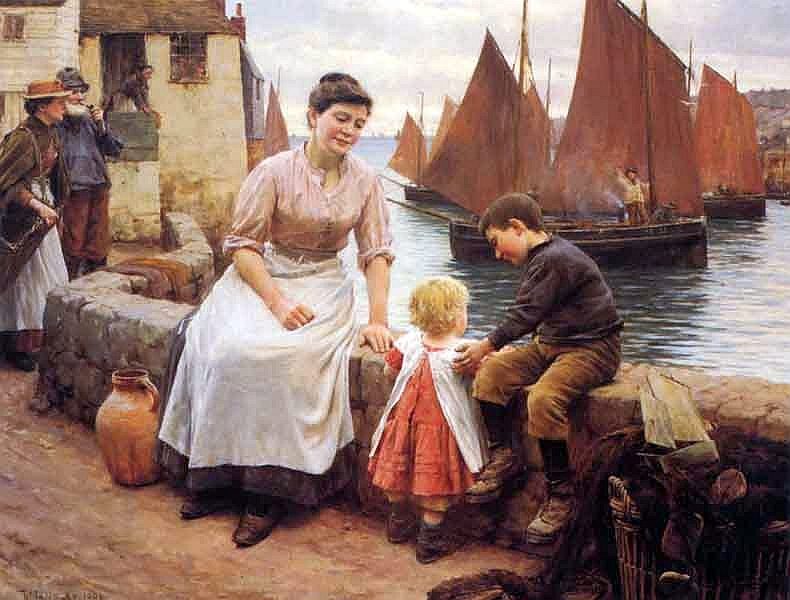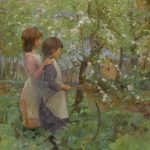
The Newlyn School, a late 19th-century artist colony, emerged as a vibrant force in British art history. Nestled in the coastal village of Newlyn in Cornwall, this collective of painters found inspiration in the region’s dramatic landscapes and quaint fishing communities. Their work reflected an intimate portrayal of rural life, combining the realism of their subjects with the plein-air techniques they had adopted from European influences. This distinctive blend set the Newlyn School apart as a movement grounded in authenticity and humanity.
During the 1880s and early 1900s, Newlyn became a haven for artists drawn to its affordability and unspoiled scenery. The area’s unique quality of light, shaped by its proximity to the sea, played a significant role in shaping the artistic vision of its residents. Newlyn’s fishing industry and its cultural rhythms became a central theme, offering painters an endless source of dynamic, lived experiences to capture on canvas. This immersion in the day-to-day lives of the working class formed the cornerstone of the Newlyn School’s ethos.
The movement’s broader context lies in its connection to other art colonies, particularly the Barbizon School in France and the Impressionists. Both groups prioritized painting outdoors to capture the transient effects of light and atmosphere, techniques that deeply influenced the Newlyn artists. Unlike the Impressionists, however, the Newlyn School leaned heavily into narrative and realism, often depicting somber or contemplative scenes that highlighted the struggles and joys of rural life.
The Newlyn School’s significance extends beyond its artistic contributions; it represents a cultural bridge between the traditions of the past and the innovations of modern art. As a movement, it challenged the rigidity of academic painting while retaining a deep respect for craftsmanship and storytelling. This balance ensured its legacy as one of the most authentic portrayals of British rural life during a time of profound societal change.
Founding of the Newlyn School
The Newlyn School’s origins trace back to the late 19th century when a group of pioneering artists sought refuge in Cornwall’s tranquil landscapes. The movement began as a response to the industrialization sweeping through Britain, which left many artists yearning for simpler, more pastoral settings. Newlyn, with its affordable living conditions and stunning views of the Atlantic, became an ideal retreat. Artists were captivated by the village’s charm and the close-knit community that thrived there.
Central to the founding of the Newlyn School was Stanhope Forbes, often referred to as its “Father.” Born in 1857 in Dublin, Forbes received his artistic training at the Royal Academy in London and later honed his craft in Paris under the influence of the Barbizon School. His exposure to plein-air painting in France inspired him to bring this approach back to Britain. Forbes settled in Newlyn in 1884, where his masterpiece, A Fish Sale on a Cornish Beach, marked the beginning of his lifelong dedication to capturing Cornish life.
Forbes’s marriage to Elizabeth Forbes in 1889 further cemented his influence on the movement. Elizabeth, an accomplished artist in her own right, shared her husband’s passion for rural realism and brought a unique perspective to the Newlyn School. Together, they fostered a sense of collaboration and mentorship within the colony, welcoming both established artists and emerging talents. Their partnership symbolized the harmonious blending of individual creativity with a collective vision.
The Newlyn School was also shaped by the camaraderie of its members, who often worked side by side and shared ideas. This communal spirit distinguished the movement from other artist colonies and imbued their work with a cohesive identity. Beyond painting, the group’s founders advocated for the preservation of local traditions, recognizing the value of cultural heritage in an increasingly industrialized world.
Prominent Artists and Their Contributions
The Newlyn School’s legacy owes much to the extraordinary talents of its members, whose works have endured as masterpieces of British art. Stanhope Forbes, a towering figure in the movement, is celebrated for his ability to capture the essence of Cornwall’s fishing communities. His paintings, such as A Fish Sale on a Cornish Beach and The Health of the Bride, demonstrate his commitment to realism and his skill in depicting natural light. Forbes’s works remain emblematic of the Newlyn School’s dedication to authenticity and emotional depth.
Elizabeth Forbes brought a fresh perspective to the Newlyn School, particularly through her focus on children and family life. Her painting School is Out is a poignant depiction of rural education, highlighting her ability to convey innocence and curiosity. As one of the few prominent female artists of her time, Elizabeth’s contributions not only enriched the movement but also paved the way for greater recognition of women in art. Her unique voice lent a tender, introspective quality to the school’s body of work.
Walter Langley, another founding member, is renowned for his empathetic portrayals of working-class life. His masterpiece Between the Tides captures the struggles of Cornish fishermen with an honesty that resonated deeply with viewers. Langley’s use of watercolors, a medium often overlooked in serious art circles, showcased his technical prowess and innovative spirit. His works reflect the hardships and dignity of labor, aligning perfectly with the Newlyn School’s ethos.
Thomas Cooper Gotch and Frank Bramley added further depth to the movement with their distinctive styles. Gotch, known for his romanticized and symbolic works, brought a sense of otherworldly beauty to the school’s portfolio. Bramley’s A Hopeless Dawn exemplifies the emotional intensity that characterizes much of the Newlyn School’s output. Together, these artists created a rich tapestry of themes and techniques that defined the movement and ensured its lasting impact.
Themes and Techniques in Newlyn School Art
The art of the Newlyn School is characterized by its commitment to realism, naturalism, and the plein-air technique. One of the defining features of their work was the depiction of rural and maritime life, often portraying scenes of fishing communities and domestic settings. These paintings offer a glimpse into the daily struggles and triumphs of Cornwall’s working-class population. By focusing on ordinary people and their surroundings, the Newlyn artists celebrated the dignity and resilience of human labor.
A hallmark of Newlyn School art is its use of natural light, which lends an air of authenticity to their works. Painters would often work outdoors to capture the fleeting effects of sunlight on water, stone, and skin. This technique, borrowed from French Impressionism, was adapted to fit the school’s preference for muted tones and detailed narrative elements. The interplay of light and shadow became a key tool for evoking mood and atmosphere in their compositions.
Recurring themes in Newlyn art include the bond between individuals and their environment, the passage of time, and the universal experiences of love, loss, and hope. Maritime scenes frequently appear, with fishing boats, harbors, and stormy seas serving as both backdrops and central subjects. These works not only highlight the natural beauty of Cornwall but also underscore the interdependence of the community and the sea. The artists’ ability to balance beauty with hardship set their work apart from more romanticized depictions of rural life.
European influences played a significant role in shaping the techniques of the Newlyn School. The Barbizon School’s emphasis on painting directly from nature and the Impressionists’ focus on light and color were evident in Newlyn works. However, the movement retained a distinctly British sensibility, favoring narrative over abstraction and celebrating the unique character of Cornwall’s people and landscapes. This fusion of influences created a body of work that is both universal and deeply rooted in its local context.
Legacy and Influence of the Newlyn School
The Newlyn School’s impact extends far beyond its time, shaping the trajectory of British art and inspiring future generations. One of its most enduring legacies is the establishment of the Newlyn Art Gallery, which continues to celebrate the school’s contributions and promote contemporary art. This institution stands as a testament to the movement’s lasting relevance and its role in nurturing creativity within Cornwall and beyond. Through exhibitions and educational programs, the gallery keeps the spirit of the Newlyn School alive.
The movement’s influence can also be seen in its emphasis on realism and naturalism, which resonated with later British artists. The Newlyn School’s approach to storytelling through art paved the way for the development of modern figurative painting. Its focus on community and everyday life continues to inspire artists seeking to document the human experience in all its complexity. By bridging the gap between traditional and modern art, the Newlyn School carved out a unique space in art history.
Cultural tourism in Cornwall owes much to the legacy of the Newlyn School. Visitors flock to the region to experience the landscapes and villages that inspired the movement’s masterpieces. This interest has not only bolstered the local economy but also heightened awareness of Cornwall’s artistic heritage. The preservation of historical sites and artworks associated with the Newlyn School ensures that its story remains accessible to future generations.
Despite its relatively short-lived prominence, the Newlyn School’s contributions to art and culture remain significant. Its members demonstrated the power of collaboration and community in the creative process, proving that art can be both beautiful and socially meaningful. The movement’s ability to capture the spirit of a place and its people continues to resonate, making it a cornerstone of British art history.
Why the Newlyn School matters today
As a movement, the Newlyn School exemplifies the transformative power of art to capture the essence of a time and place. Its members’ dedication to their craft and community created a body of work that is as much about heart as it is about skill. For anyone seeking inspiration, the Newlyn School offers a timeless reminder of art’s ability to illuminate life’s most profound truths. Through their work, these artists preserved not only the visual beauty of Cornwall but also the universal emotions of love, labor, and resilience.
The Newlyn School continues to matter because it reminds us of the power of storytelling in art. By focusing on the lived experiences of ordinary people, its members celebrated the humanity in every gesture, task, and interaction. Their art is both a reflection of its time and a message to the future, urging viewers to look beyond the surface and see the dignity and value of everyday life. In an age when so much art seeks spectacle, the Newlyn School reminds us of the beauty in simplicity and authenticity.
The movement also holds relevance for modern artists and art lovers by illustrating the importance of collaboration and shared purpose. In Newlyn, painters of varying styles and backgrounds worked side by side, inspiring and challenging one another to grow. This sense of community is a model for creative endeavors today, showing that the best art often arises from environments where ideas are exchanged, and people support one another in their pursuit of excellence.
In celebrating the Newlyn School, we celebrate the enduring power of art to connect us to our shared past while inspiring our present and future. These artists may have painted scenes of one small village, but the emotions they captured speak to the universal human experience. Their legacy lives on, not only in museums and galleries but also in the hearts of those who find meaning in their work. The Newlyn School is more than a chapter in art history—it is a reminder that art, at its best, captures the soul of humanity.




